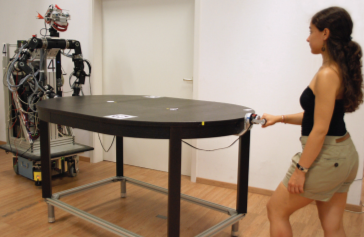
Since the strict separation of working spaces of humans and robots has experienced a softening due to recent robotics research achievements, close interaction of humans and robots comes rapidly into reach. In this context, physical human– robot interaction raises a number of questions regarding a desired intuitive robot behavior. The continuous bilateral information and energy exchange requires an appropriate continuous robot feedback. Investigating a cooperative anipulation task, the desired behavior is a combination of an urge to fulfill the task, a smooth instant reactive behavior to human force inputs and an assignment of the task effort to the cooperating agents. In this paper, a formal analysis of human–robot cooperative load transport is presented. Three different possibilities for the assignment of task effort are proposed. Two proposed dynamic role exchange mechanisms adjust the robot’s urge to complete the task based on the human feedback. For comparison, a static role allocation strategy not relying on the human agreement feedback is investigated as well. All three role allocation mechanisms are evaluated in a user study that involves large-scale kinesthetic interaction and full-body human motion. Results show tradeoffs between subjective and objective performance measures stating a clear objective advantage of the proposed dynamic role allocation scheme.
Key words: cooperative manipulation, human feedback, input decomposition, load sharing, kinesthetic interaction
Authors: A. Mortl, M. Lawitzky, A. Kucukyilmaz, T. M. Sezgin, C. Basdogan, S. Hirche.